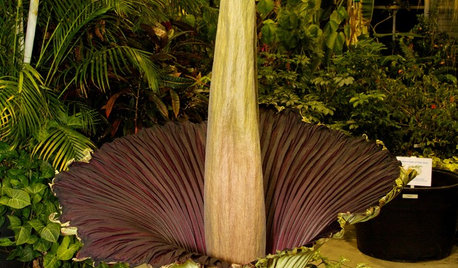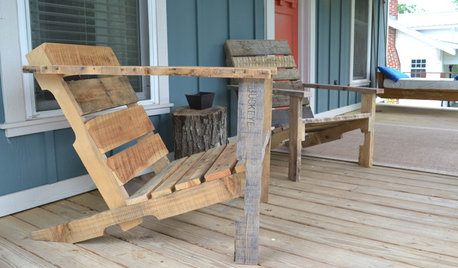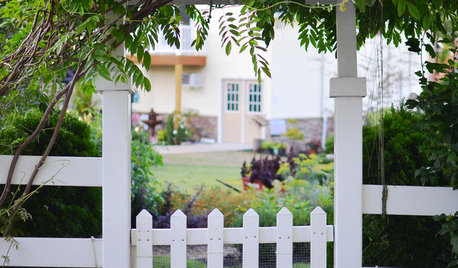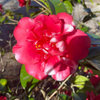It can be fun to breed your own zinnias - Part 14
zen_man
13 years ago
Related Stories

TRANSITIONAL HOMESHouzz Tour: Part Traditional, Part Modern and All Family Friendly
With clean lines, vintage touches and durable surfaces everywhere, this Los Angeles home balances tastes and needs beautifully
Full Story
LIFEFun Houzz: 14 Signs You’re an Interiors Geek
Are you obsessed with interiors? It’s OK, you can admit it — you’re among friends
Full Story
FUN HOUZZSmell This Shocking Flower at Your Own Risk
Don't say we didn't warn you: The foul scent of the rare and incredible corpse flower may knock your socks off
Full Story
WOODWORKINGBuild Your Own Wooden Deck Chair From a Pallet — for $10!
Take the ecofriendly high road with a low-cost outdoor chair you make yourself
Full Story
BUDGET DECORATING14 Ways to Make More Money at a Yard Sale — and Have Fun Too
Maximize profits and have a ball selling your old stuff, with these tips to help you plan, advertise and style your yard sale effectively
Full Story
HOUZZ TVHouzz TV: This Dream Midcentury Home in a Forest Even Has Its Own Train
Original wood ceilings, a cool layout and, yes, a quarter-scale train persuaded these homeowners to take a chance on a run-down property
Full Story
PETSWhat Chihuahuas Can Teach Us About Interior Design
Who knew these tiny dogs could be such a huge fount of design tips? Houzzers did
Full Story
GARDENING GUIDES10 Tips to Start a Garden — Can-Do Ideas for Beginners
Green up your landscape even if you're short on time, money and knowledge, with these manageable steps for first-time gardeners
Full Story
KIDS’ SPACESA Place of His Own: Boy's First Bedroom
Colorful, creative, themed or not, boys' bedrooms like these encourage happy times
Full Story
HOUSEKEEPINGChoose Your Own Spring Cleaning Plan
Instead of trying to do it all, pick one of these six cleaning approaches that’s right for you now
Full StoryMore Discussions







jackier_gardener
jackier_gardener
Related Professionals
Windham Landscape Architects & Landscape Designers · Middletown Landscape Contractors · Edmond Landscape Contractors · Cudahy Landscape Contractors · Dudley Landscape Contractors · Nanuet Landscape Contractors · New Cassel Landscape Contractors · North Richland Hills Landscape Contractors · Peoria Landscape Contractors · Weymouth Landscape Contractors · Milpitas Driveway Installation & Maintenance · Ashburn Decks, Patios & Outdoor Enclosures · Knoxville Decks, Patios & Outdoor Enclosures · Lakewood Decks, Patios & Outdoor Enclosures · West Bend Decks, Patios & Outdoor Enclosureszen_manOriginal Author
jackier_gardener
jackier_gardener
zen_manOriginal Author
jackier_gardener
zen_manOriginal Author
zen_manOriginal Author
jackier_gardener
zen_manOriginal Author
jackier_gardener
zen_manOriginal Author
jackier_gardener
zen_manOriginal Author
jackier_gardener
jackier_gardener
siichan
jackier_gardener
zen_manOriginal Author
zen_manOriginal Author
jackier_gardener
zen_manOriginal Author
zen_manOriginal Author
jackier_gardener
zen_manOriginal Author
zen_manOriginal Author
jackier_gardener
zen_manOriginal Author
jackier_gardener
jackier_gardener
zen_manOriginal Author
jackier_gardener
jackier_gardener
zen_manOriginal Author
jackier_gardener
zen_manOriginal Author
jackier_gardener
zen_manOriginal Author
jackier_gardener
zen_manOriginal Author
jackier_gardener
zen_manOriginal Author
jackier_gardener
zen_manOriginal Author
jackier_gardener
zen_manOriginal Author
zen_manOriginal Author
jackier_gardener
zen_manOriginal Author